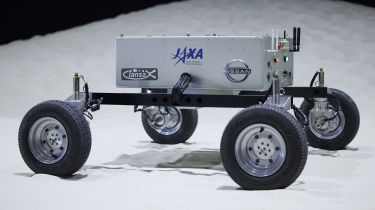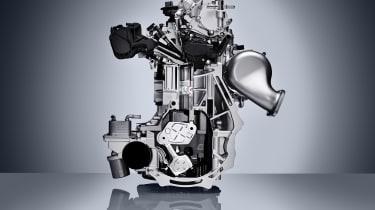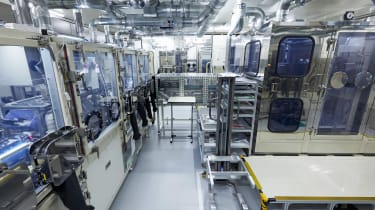From moon-roving to reading minds - Nissan’s tech leadership detailed
Nissan has a long history of impressive technical innovations, and as we look to the motoring future, this is more important than ever


Nissan is a company that never stops innovating. Whether it’s developing and delivering technical features for cars available in the showroom now or looking at advances still many years away in the future, Nissan is there.
With the motoring landscape changing rapidly through electrification and driver assistance, Nissan’s innovations are more important than ever. Here are just a few of them from recent years:
Variable compression
The concept of an engine with a variable compression ratio has been around for decades, but it’s Nissan that used its tech leadership to become the first manufacturer to bring this technology to the market.
Usually, a compression ratio is a compromise between two opposing ideals - performance and efficiency. But with Nissan’s VC-Turbo engine, used in the e-POWER hybrid setup, you can have it both ways. Inside, it doesn’t have con-rods to join the pistons to the crankshaft, instead using a sophisticated set of multi-link devices that are actuated by a motor.

With these, the pistons are able to adopt different top dead centre (TDC) and bottom dead centre (BDC) positions, giving compression ratios as low as 14:1 for the best efficiency, or as high as 8:1 for better performance.
Brain-to-vehicle
The human brain is an incredible thing, but in terms of response time, there’s room for improvement. This is where Nissan’s Brain-to-Vehicle technology - the first system in the world that can detect driving-related brain activity - comes in.
Intended for a fully autonomous future, the system works via a skullcap worn by the driver. This picks up the driver’s intentions before they’d be able to initiate ‘intentional movement’ (for instance, steering or accelerator input) and put them into action. The system can react up to half a second faster than a typical human response time.
This could be used in several ways. For example, in an autonomous driving mode, the car could detect driver discomfort and make the necessary adjustments to driving style to resolve this. Or in a manual driving mode on a twisty road, Brain-to-Vehicle’s improved responses would help a keen driver perform better than they might if making control inputs using their hands and feet.
The first mass-market EV
Back in 2010, there wasn’t really an electric car market at all. There were a smattering of more specialist options available and a handful of fairly crude quadricycles - often powered by lead-acid batteries - and not a whole lot else. Into this still very combustion-reliant motoring landscape, Nissan helped kickstart an electric revolution with the Leaf.
The Leaf came onto the scene with a range of well over 100 miles and fast-charging capability using an expanding network of public chargers that Nissan played a role in establishing. Innovation then continued throughout the first-generation Leaf’s life, keeping the car’s impressive sales momentum going. From the world’s first vehicle-to-home energy sharing system to larger batteries delivering even more range and more efficiency, Nissan didn’t stop improving the Leaf, but by 2017 was facing increasing competition.

It was then time for an all-new Leaf, featuring double the range of the original model from a much more power-dense battery, and useful features such as the ProPILOT suite of driver assistance technology and the ‘e-Pedal’ driving system.
In its second generation, the Leaf continued to win over buyers, with production passing the 500,000 mark in 2020.
A solid-state future
Huge advances have been made in the realm of fully electric vehicles since Nissan launched the Leaf just over a decade ago. The biggest leap of all, however, might be yet to come - solid-state batteries.
In place of the liquid-based electrolyte used in the cells of lithium-ion batteries, solid-state units adopt a thin, solid electrolyte usually made from ceramic or solid polymers. This won’t mean much to the average motorist, but the benefits of this set-up are much easier to understand: solid-state batteries are lighter, cheaper due to the use of less exotic raw materials in their construction, and they charge significantly quicker.
There are many challenges involved in making solid-state batteries a reality for production EVs, but Nissan is already forging ahead in tackling these. In early 2022, a prototype solid-state production facility was established at the Nissan Research Center in Kanagawa Prefecture, Japan.

Here, Nissan engineers will use lessons learned from battery production with the intention of reducing the cost of manufacture to the point where EVs will cost the same as their combustion-engined counterparts to purchase. It’ll help Nissan achieve its goal of launching a solid-state-powered car as soon as 2028.
From the Earth to the Moon
Nissan’s e-4ORCE all-wheel drive technology is perhaps most famous for its use on the mighty R35 GT-R, and more recently, the fully electric Ariya. The software behind E-4ORCE could end up some way beyond the world’s road networks - further, even, than the stratosphere.
In its research on lunar rovers for future missions to the moon, the Japan Aerospace Exploration Agency (JAXA) turned to the technical expertise of Nissan to see how e-4ORCE could be used to increase traction on the rocky, undulating terrain of Earth’s sole natural satellite.
On a prototype rover, e-4ORCE helps vary the output of each motorised wheel independently, allowing the vehicle to tackle the kind of terrain which would otherwise stop it in its tracks. The benefits of collaborations like this go both ways, with Nissan being able to apply lessons learned from working with third parties to its road cars.
So in the future, your Nissan road car might well benefit from technology which is - quite literally - out of this world.
